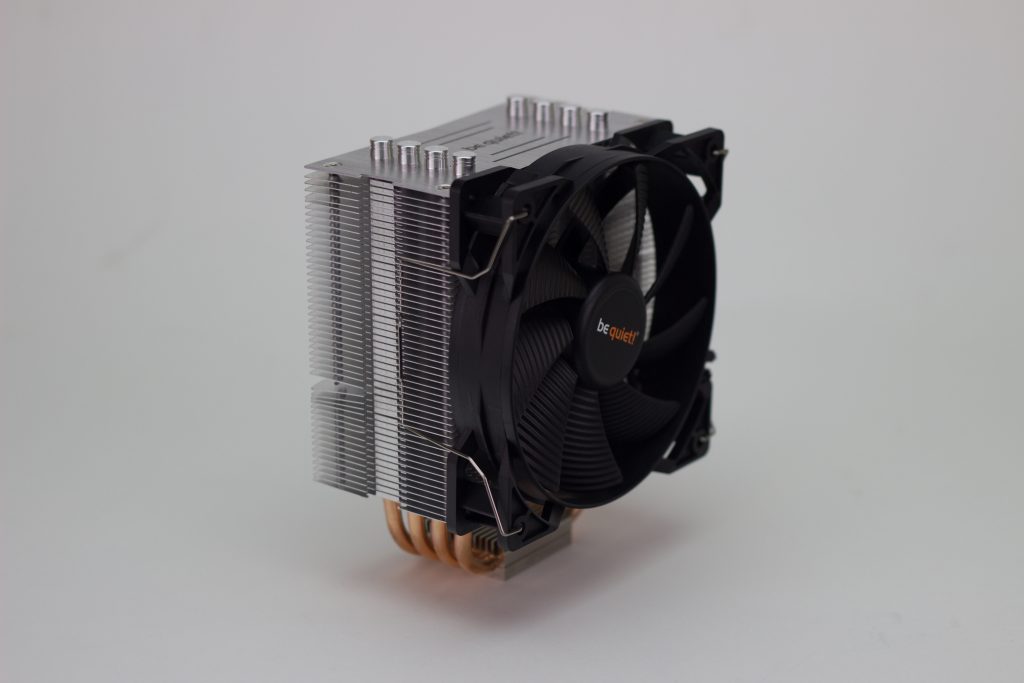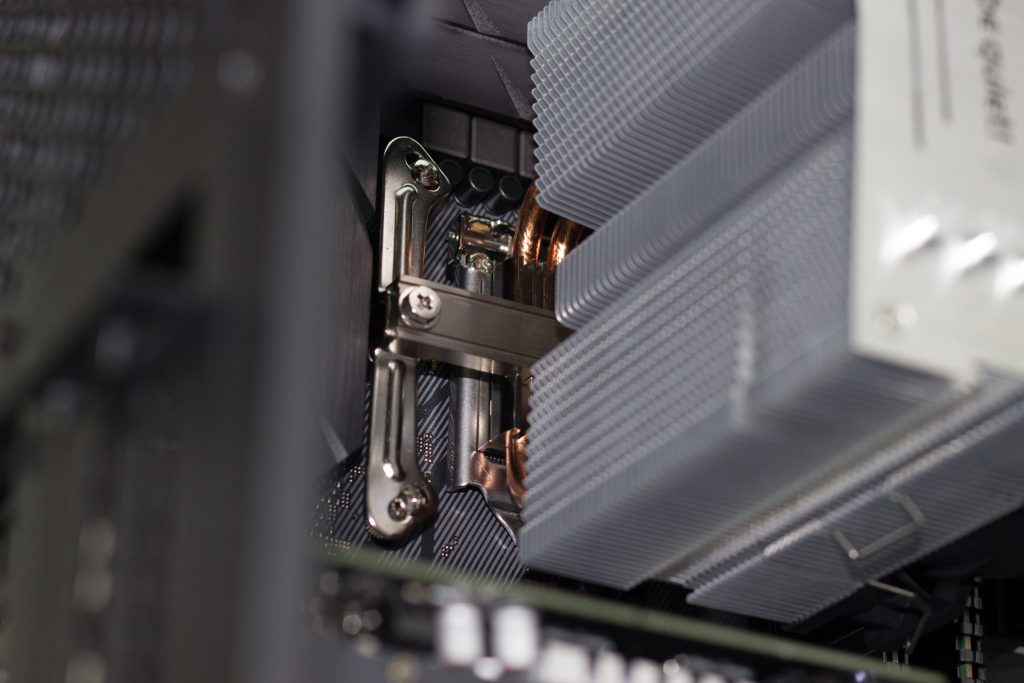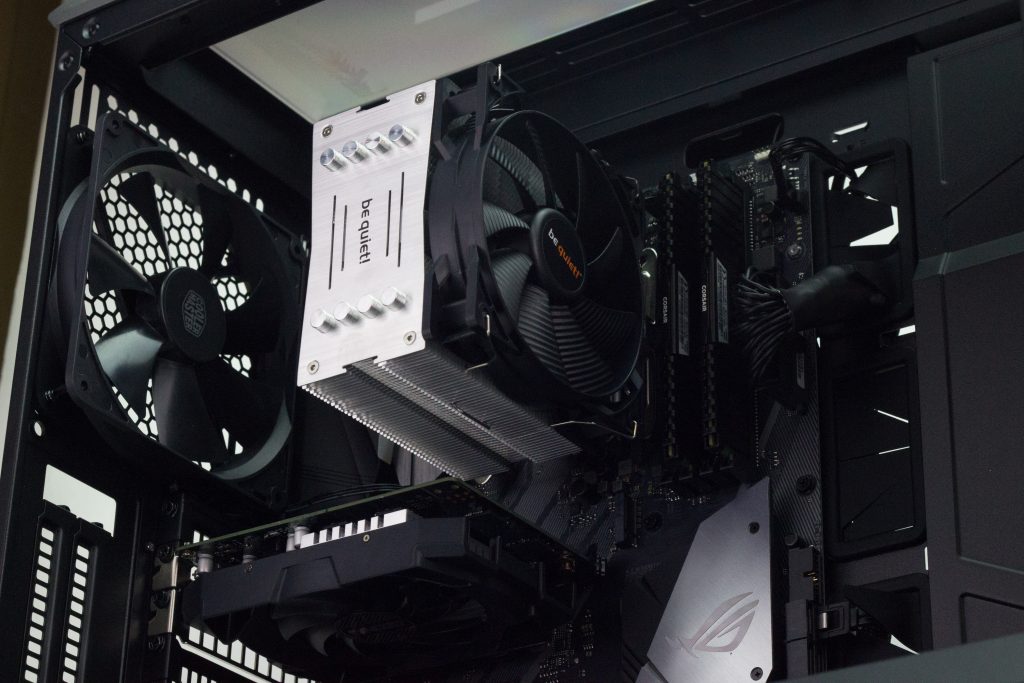
At £29.99 the Pure Rock is a great little cooler, it combines the great aesthetic we’re used to with be quiet! products with pretty good performance, rivaling the legendary Hyper 212 Evo in terms of TDP. It has great Socket Compatibility with support for every modern socket aside from TR4, it also comes with a be quiet! Pure Wings 2 fan which does a good enough job of moving air through the heatsink whilst keeping noise levels at a more than acceptable level. The Pure Rock also has a small heatsink directly above the cold plate, the middle section of this is used to hold the mounting bar in place when screwing it down onto the other hardware. This heatsink also adds to the aesthetics of the cooler, and does actually contribute to the cooling performance.
The Pure Rock boasts a TDP of 150W which is also what the similarly priced CoolerMaster MasterAir MA410P is rated for, they are also similar in size and both have four heatpipes so it will be interesting to see how they stack up against each other.
Tech Specs
- Height – 155mm
- TDP – 150W
- Weight – 660g
- Socket Compatibility - LGA 775, 115x, 1366, LGA2011, 2066, AM2 (+), AM3 (+), AM4, FM1, FM2 (+).
- Included Fan(s) – be quiet! Pure Wings 2 (22.1 dBA @ 75%
What’s in the box?
- be quiet! Pure Rock CPU Cooler
- be quiet! Pure Wings 120mm “silence-optimised” fan
- Mounting hardware for all above sockets
- Hardware to mount a second 120mm fan
- Mounting instructions
- Warranty information

Mounting
It is evident that be quiet! have put a lot of time into developing their mounting for the Pure Rock. It is very well put together and secures the cooler very well, it also manages to support all modern sockets with a small amount of hardware, unlike some coolers which have completely different hardware for each socket, however this does make it feel like it has more steps than it actually needs.
The clip that holds on the Pure Wings 120mm fan works perfectly when installing it, but when it comes to taking it off it can be tricky without damaging the cooler, would be nice to see be quiet! work out another way to do this to make it more user friendly, we like CoolerMaster’s plastic fan holders which also do a good job of containing the airflow. These clips that hold on the fan are good in the fact that they make it very easy to move the fan up and down if you're working with less RAM clearance. One nice thing with the mounting is the slotted top of the standoffs to make it easier to install with a screwdriver.

Aesthetic
The Pure Rock really hits it out of the park when it comes to looks, the top of the cooler really steals the show with its brushed aluminium top fin, heat pipe caps and the be quiet! logo and grooves cut out of the top fin. The fan also looks very good with the all black design that be quiet! is known for. Compared to other coolers in this price bracket, we’d say this is the best looking of them all. No it doesn’t have addressable RGB fans or coloured heatsink covers but the look it does have makes it look like a premium product, and we're sure that's exactly what be quiet! were trying to achieve when designing this cooler.

Performance
Arguably the most important part of the review, the performance. We tested the be quiet! Pure Rock in a few different tests and compared it against its competition. We decided to test the Pure Rock with a processor that would test it to it's full potential so chose the Intel i7 8700k on a board that could happily overclock it to a stable 5.0GHz. Below are the exact system specs that we decided to use for the test system.
Test System Specs
- Processor - Intel i7 8700k
- Case - CoolerMaster H500P
- RAM - Corsair Vengeance DDR4 16GB 3000Mhz (2x8)
- Motherboard - Asus Rog Strix Z370-F
- SSD - Samsung 860 EVO 250GB
- PSU - Corsair RM750x
- GPU - EVGA GTX 1050Ti
We’ll be comparing the be quiet! Pure Rock against all of our other air coolers, the main competition is the CoolerMaster MasterAir MA410P, CoolerMaster Hyper 212 EVO and the Noctua NH-U12S.
We used a few different pieces of software for the testing, to stress the CPU we used the 3DMark Time Spy CPU Test, Prime95 with the Blend Preset and Aida64 CPU+FPU to squeeze the coolers to breaking point. We also used Aida64's temperature logging function for the results.
We ran my tests with the stock voltage and frequency settings and with an overclock, we managed to get a stable overclock of 5.0GHz at 1.35v which are the settings used for everything marked "OC".
All tests were performed in our lovely climate controlled test room at a steady 21°C ambient temperature. Fan speeds were determined by the motherboard's default setting, don't worry we'll be sure to let you know if it gets too loud. (Spoiler alert: It didn't, no surprise there.)
We were very impressed by the performance of the Pure Rock, especially when taking into account the £29.99 price tag. The graph below shows the average temperature over a 20 minute stress test using Prime95's blend preset. We found this test to be the best at showing the performance of these air coolers visually due to the range being much higher than other tests.
As expected, the performance of the Pure Rock isn't the best out of the lot, it does fit nicely with the CoolerMaster Hyper 212 EVO which is a very similar cooler in terms of TDP rating and price.
Conclusion
To sum everything up in a short statement, the be quiet! Pure Rock is an impressive little cooler from a company that is known for their more expensive products. In terms of performance it competes with the similarly priced CoolerMaster Hyper 212 Evo, however in my opinion the Pure Rock looks much nicer, if it was in my own build I'd choose the Pure Rock over the classic 212 Evo. It really seems that be quiet! have put a lot of work into the Pure Rock as it is very well thought out, for example the standoff pieces to mount the cooler come slotted so you can use a screwdriver to install them and not destroy your fingers trying to install them by hand.
Pros
- Well thought out mounting system
- It looks fantastic
- It's a be quiet! cooler with decent performance for under £30
Cons
- It's a nightmare to get back in the box
- More expensive than the equally performing CoolerMaster Hyper 212 Evo
 At £29.99 the Pure Rock is a great little cooler, it combines the great aesthetic we’re used to with be quiet! products with pretty good performance, rivaling the legendary Hyper 212 Evo in terms of TDP. It has great Socket Compatibility with support for every modern socket aside from TR4, it also comes with a be quiet! Pure Wings 2 fan which does a good enough job of moving air through the heatsink whilst keeping noise levels at a more than acceptable level. The Pure Rock also has a small heatsink directly above the cold plate, the middle section of this is used to hold the mounting bar in place when screwing it down onto the other hardware. This heatsink also adds to the aesthetics of the cooler, and does actually contribute to the cooling performance.
The Pure Rock boasts a TDP of 150W which is also what the similarly priced CoolerMaster MasterAir MA410P is rated for, they are also similar in size and both have four heatpipes so it will be interesting to see how they stack up against each other.
At £29.99 the Pure Rock is a great little cooler, it combines the great aesthetic we’re used to with be quiet! products with pretty good performance, rivaling the legendary Hyper 212 Evo in terms of TDP. It has great Socket Compatibility with support for every modern socket aside from TR4, it also comes with a be quiet! Pure Wings 2 fan which does a good enough job of moving air through the heatsink whilst keeping noise levels at a more than acceptable level. The Pure Rock also has a small heatsink directly above the cold plate, the middle section of this is used to hold the mounting bar in place when screwing it down onto the other hardware. This heatsink also adds to the aesthetics of the cooler, and does actually contribute to the cooling performance.
The Pure Rock boasts a TDP of 150W which is also what the similarly priced CoolerMaster MasterAir MA410P is rated for, they are also similar in size and both have four heatpipes so it will be interesting to see how they stack up against each other.




